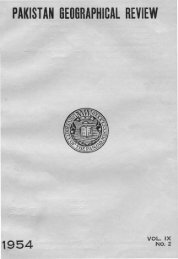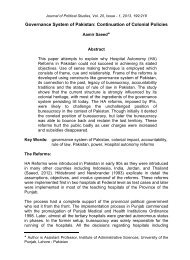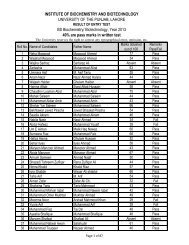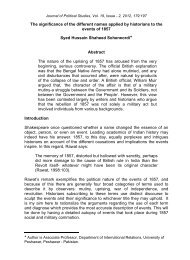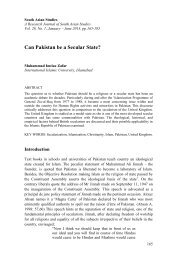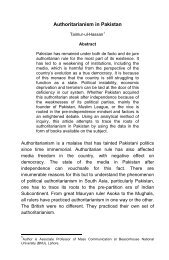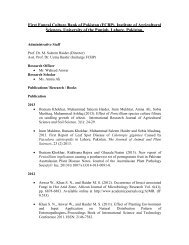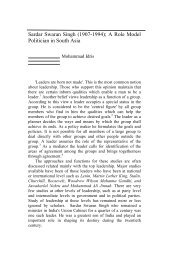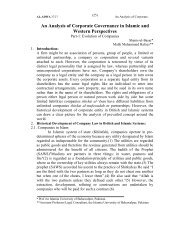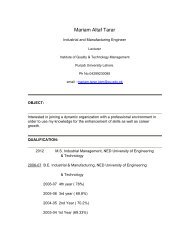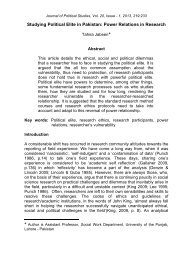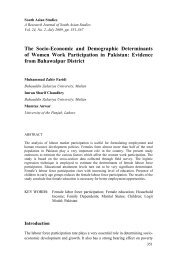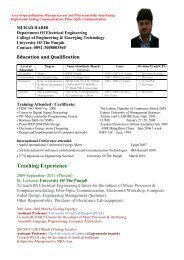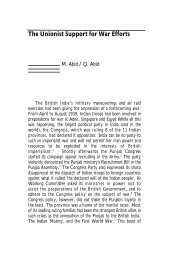Reconceptualising Domestic Violence as 'Domestic Torture'
Reconceptualising Domestic Violence as 'Domestic Torture'
Reconceptualising Domestic Violence as 'Domestic Torture'
You also want an ePaper? Increase the reach of your titles
YUMPU automatically turns print PDFs into web optimized ePapers that Google loves.
Shazia Qureshi<br />
back to 1878 (Cobbe,1878: 55-87). Cobb, the distinguished activist of the<br />
Victorian feminism, whose work on law reform is well recognized in England,<br />
w<strong>as</strong> much ahead of her time in describing domestic violence <strong>as</strong> torture<br />
(https://pi.library.yorku.ca/ojs/index.php/topia/article/viewFile/441/12258)<br />
Cobbe’s influence w<strong>as</strong> most felt through her writings, she published an article<br />
‘Wife Torture in England’ to support a new bill then presented in parliament<br />
(Cobbe,1878). Cobbe had noted that:<br />
..the unendurable mischief, the discovery of which h<strong>as</strong> driven<br />
me to try to call public attention to the whole matter, is this—<br />
wife beating in process of time and in numberless c<strong>as</strong>es,<br />
advances to wife torture and the wife torture usually ends in<br />
wife maiming, wife blinding or wife murder (Cobbe,1878: 72).<br />
She supported her arguments with statistics of femicide and numerous<br />
accounts of extreme brutality carried out by men in the home. Matrimonial<br />
Causes Acts 1878 w<strong>as</strong> p<strong>as</strong>sed <strong>as</strong> a result, her major achievement in this<br />
regard that enabled battered wives to obtain separation orders against their<br />
abusive husbands. That being said, Cobbe’s reconception of domestic<br />
violence <strong>as</strong> torture perhaps w<strong>as</strong> neither meant in the sense in which it is<br />
understood in the International human rights law nor w<strong>as</strong> it done with an<br />
intention to attain any goal in this realm. Instead her primary purpose of using<br />
this terminology w<strong>as</strong>, arguably, to equate the quantum of pain/suffering<br />
involved in the two forms of violence. By so doing she sought to expand legal<br />
options available to women victims of domestic violence within UK.<br />
It is in the 1990s that feminist legal activism, recognizing the striking parallels<br />
between the two forms of violence, put forward the concept of domestic<br />
violence <strong>as</strong> torture (Edward, 2006: 350-51). The analogies between domestic<br />
violence and torture were drawn b<strong>as</strong>ically to bring the former into the folds of<br />
HRL or more specifically to attract the provisions of the CAT (Copelon, 1993-<br />
94:299 & Youngs, 2003: 1220-21). To this end some feminist writers stress<br />
the need to channel the potential force of human rights norms, including<br />
prohibition on torture. This force arguably can be redesignated to the VAW<br />
c<strong>as</strong>es with greater tenacity and commitment than already h<strong>as</strong> been the c<strong>as</strong>e<br />
(McGlynn, 2008: 72). Copelon argues that her primary goal in this regard is to<br />
‘challenge the <strong>as</strong>sumption that intimate violence is less severe and terrible<br />
than that perpetrated by the state’ (Copelon, 1993-94: 352). She holds that<br />
such violence must be understood <strong>as</strong> torture, giving rise to international and<br />
national obligations (Copelon, 1993-94:296). Also it h<strong>as</strong> been recognized that<br />
an issue can only be properly addressed in law if it is accurately<br />
conceptualized (Meyersfelds, 2003-04:374). MacKinnon suggests that<br />
understanding various types of VAW within the ‘recognized profile’ of torture<br />
would contribute to the recognition of such abuses <strong>as</strong> a serious human rights<br />
concern (Mackinnon, 2006:17). Moreover, by recognizing the power of<br />
36



